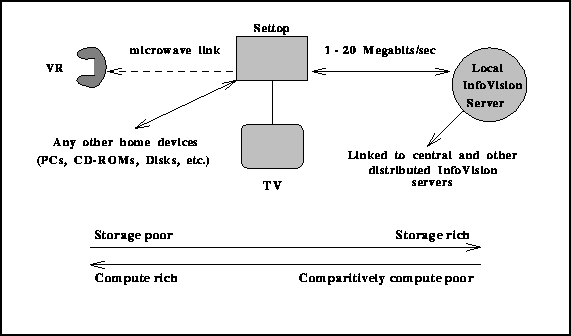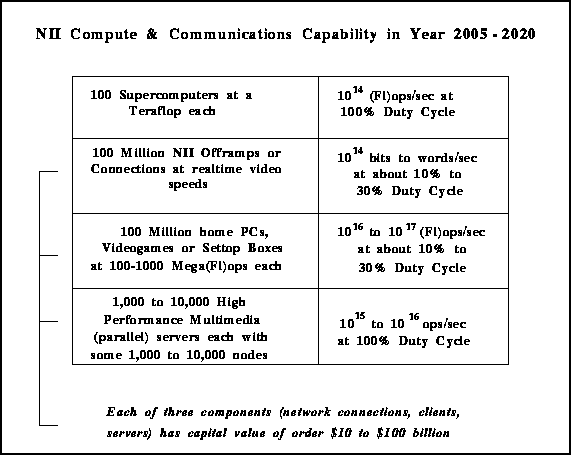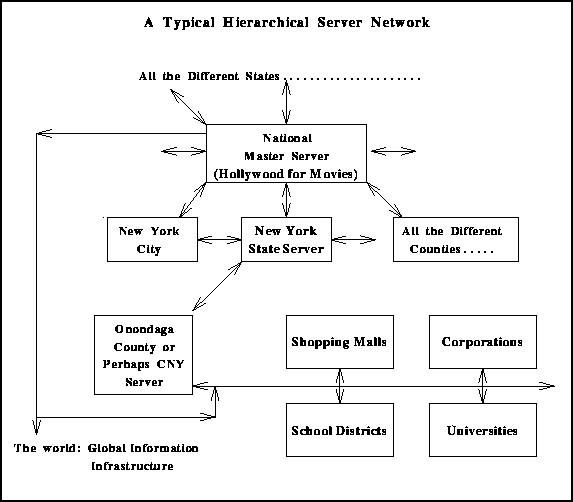High-performance distributed computers solve problems in science and
engineering. We think of these problems as simulations of airflow,
galaxies, bridges, and such things. However, presumably entertaining,
informing, and educating society is an equally valid problem.
Computers and networks of the NII will be able (see
Figure ![]() ) to deliver information at many megabits/second
to ``every'' home, business (office), and school ``desk.'' This
network can be considered as a distributed HPCC system because one
expects the information to be stored in a set of distributed multimedia
services that could vary from PCs to large MPPs and be delivered to a
larger set of clients. As shown in Figure
) to deliver information at many megabits/second
to ``every'' home, business (office), and school ``desk.'' This
network can be considered as a distributed HPCC system because one
expects the information to be stored in a set of distributed multimedia
services that could vary from PCs to large MPPs and be delivered to a
larger set of clients. As shown in Figure ![]() , one can
estimate that the total compute capability in these servers and clients
will be some hundred times greater than that of the entire set of
supercomputers in the nation.
, one can
estimate that the total compute capability in these servers and clients
will be some hundred times greater than that of the entire set of
supercomputers in the nation.

Figure: The basic InfoVISiON scenario as seen by a home in the
year 2000 with an intelligent settop box interfacing the digital home to a
hierarchical network of InfoVISiON servers

Figure: An estimate of the communication bandwidth and compute capability
contained in the NII and supercomputer industries
The computational issues in this application are somewhat different
than those for the previous cases we considered. Classic data
parallelism and languages, such as High Performance Fortran, are not
important. Large-scale distributed databases are the heart of this
application, which are accessed through the exploding set of Web
technologies. Presumably, these will need to migrate from today's
clients (PC/workstations) to more user friendly, and at least
initially less flexible settop box implementations controlling home
entertainment systems. We will find the same need for data locality
as in large scale simulations. As shown in Figure ![]() ,
when the latest Hollywood movie is released on the NII, one will not
have half the nation directly connected to Hollywood. Rather, data is
automatically replicated or cached on local servers so that one will
only need to communicate such ``hot'' information over a distance of a
few miles. As in simulation examples, communication bandwidth
will be limited and such steps are needed to reduce demand.
,
when the latest Hollywood movie is released on the NII, one will not
have half the nation directly connected to Hollywood. Rather, data is
automatically replicated or cached on local servers so that one will
only need to communicate such ``hot'' information over a distance of a
few miles. As in simulation examples, communication bandwidth
will be limited and such steps are needed to reduce demand.

Figure: A typical hierarchical server network depicted for a master system
in Hollywood cascading down with a fragment of node systems shown for
central New York
InfoVISiON will require simulation, but it will be more loosely coupled than for say large-scale CFD, and consist of very many smaller problems. Interactive videogaming with multiple players sharing a virtual world is one clear need for simulation on the NII, and for this the three-dimensional database VRML has been introduced. However, another example that can use the same technology is remote viewing and exploration of consumer products, such as cars, furniture, and large appliances. Simulation will support virtual reality like exploration and the automatic customization of such products for particular customers.
InfoVISiON at its ``simplest'' is ``just'' access to multimedia
database. But even here the ``media'' can, as in Application 24
include simulation. Further, InfoVISiON underlies decision support in
business, government, and military areas (Applications 25, 27, and 28),
as well as education (Application 33). Thus, this HPCC application is
of great importance, and can be expected to a major business
opportunity for the vendors, as shown in Figure ![]() .
.